To create therapeutic-grade oils for soapmaking, you'll need to source 100% pure essential oils from reputable suppliers following ISO guidelines. Store your oils in dark glass containers and verify their authenticity through botanical names and extraction methods. Maintain proper dilution ratios of 3-5g per 100g of soap, or 1g per 100g for facial soaps. Blend using top, middle, and base notes while allowing 48 hours rest time. Mastering these fundamentals will open the door to creating professional-quality therapeutic soaps.
Understanding Therapeutic Grade Oil Standards for Soap
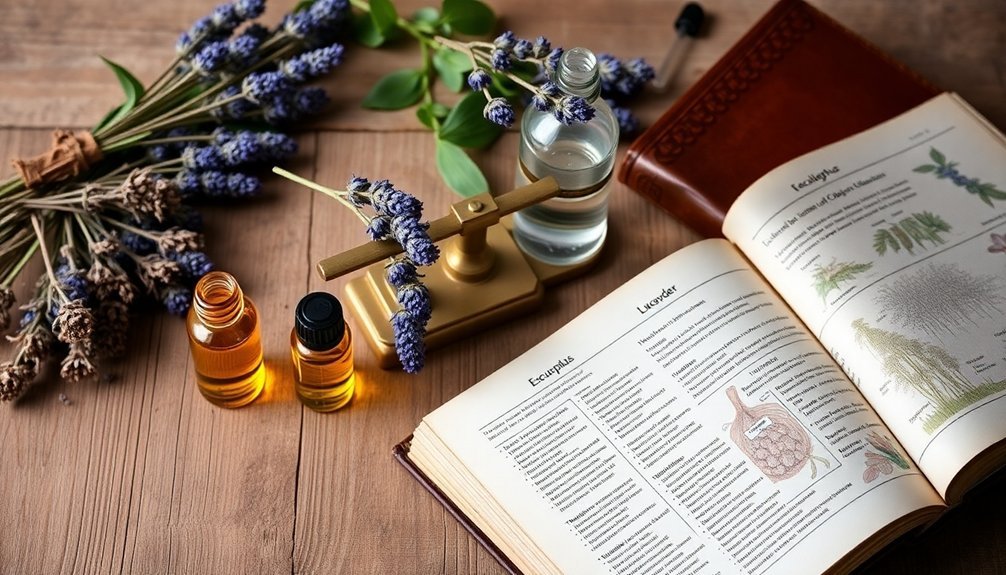
When crafting therapeutic-grade soaps, understanding the quality standards of your essential oils is crucial to achieving ideal results.
You'll want to source your essential oils from reputable suppliers who follow ISO guidelines and provide detailed information about each oil's botanical name and extraction method.
True therapeutic grade essential oils come from high-quality plant sources and undergo extensive testing to verify their purity.
When selecting oils for soap making, look for products that are 100% pure and free from synthetic additives. These oils should always come in dark glass containers to preserve their therapeutic properties.
Remember to check that each oil's label includes its botanical name and extraction method, as this information helps you understand the oil's specific properties and guarantees you're using genuine therapeutic-grade products in your soap making projects.
Essential Oil Selection and Quality Testing Methods
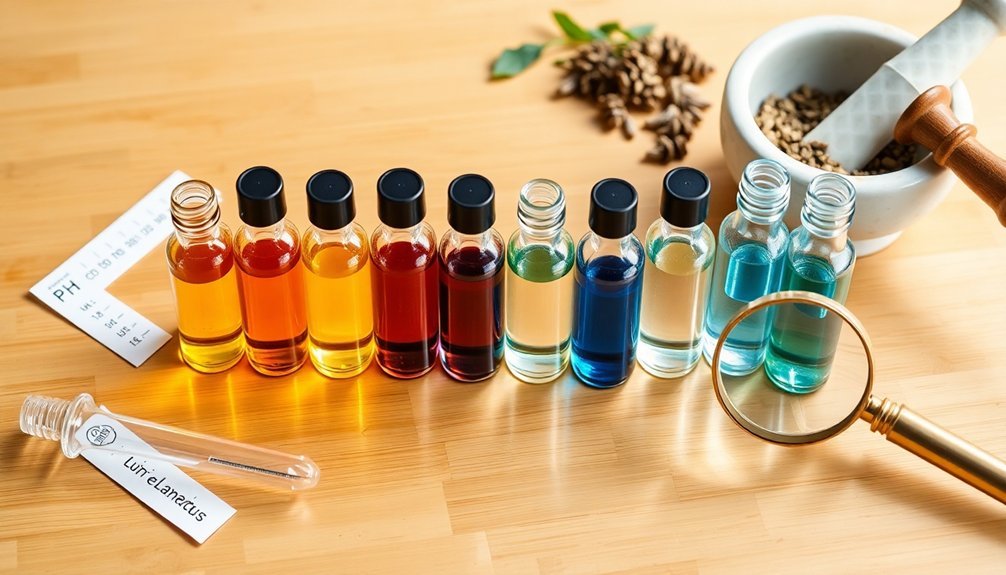
Selecting the right oils and verifying their quality forms the foundation of successful therapeutic soap making. When sourcing essential oils for soapmaking, you'll want to prioritize pure, therapeutic-grade oils from transparent, reputable brands.
Before incorporating oils into your formulations, you'll need to evaluate their characteristics through quality testing methods. Check each oil's color, viscosity, and scent potency to confirm its freshness and purity.
Research the specific therapeutic benefits of your chosen oils to guarantee they'll deliver your intended effects. Don't forget to perform a patch test on your skin to identify any potential allergic reactions before using new oils in your recipes.
Proper Dilution Ratios and Safety Guidelines
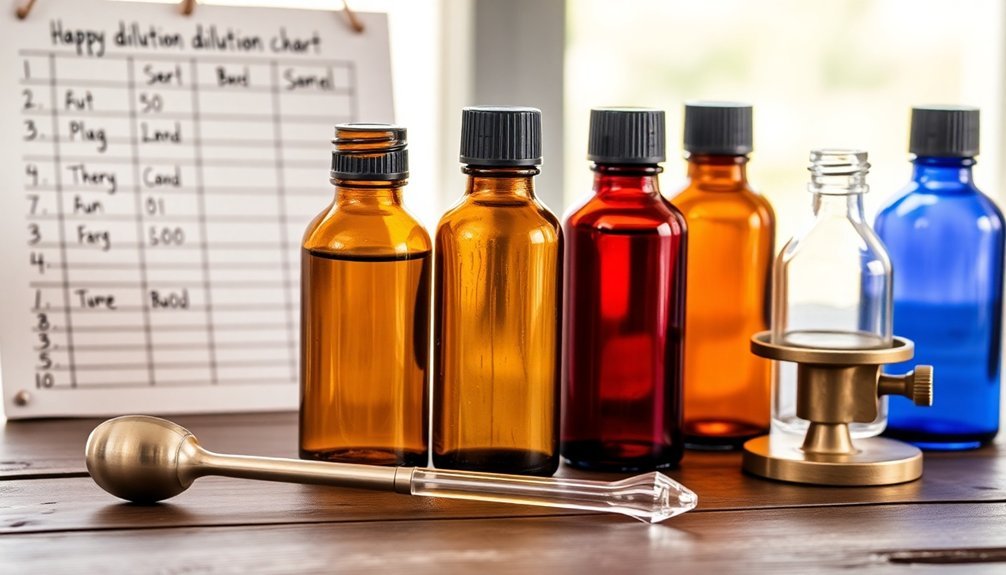
Proper dilution of essential oils serves as a critical safety measure in therapeutic soapmaking. When crafting your soap, you'll need to maintain a dilution rate of 3-5% essential oils to total base oils. For facial soaps, start with just 1% to prevent skin irritation.
Essential oil dilution is crucial for safe soapmaking. Use 3-5% for general soaps and 1% for facial formulas to protect skin.
Before using any therapeutic grade oils in your soap making, always perform a patch test to verify safety.
Here's what you need to know about proper usage:
- Keep essential oil concentrations between 3-5g per 100g of soap
- Reduce to 1g per 100g for facial applications
- Choose lavender essential oil or chamomile for sensitive skin
- Avoid concentrated citrus or mint oils if you're prone to reactions
Remember to stay within maximum usage rates for each oil type, as exceeding these limits can cause adverse skin reactions.
Blending Techniques for Maximum Therapeutic Benefits
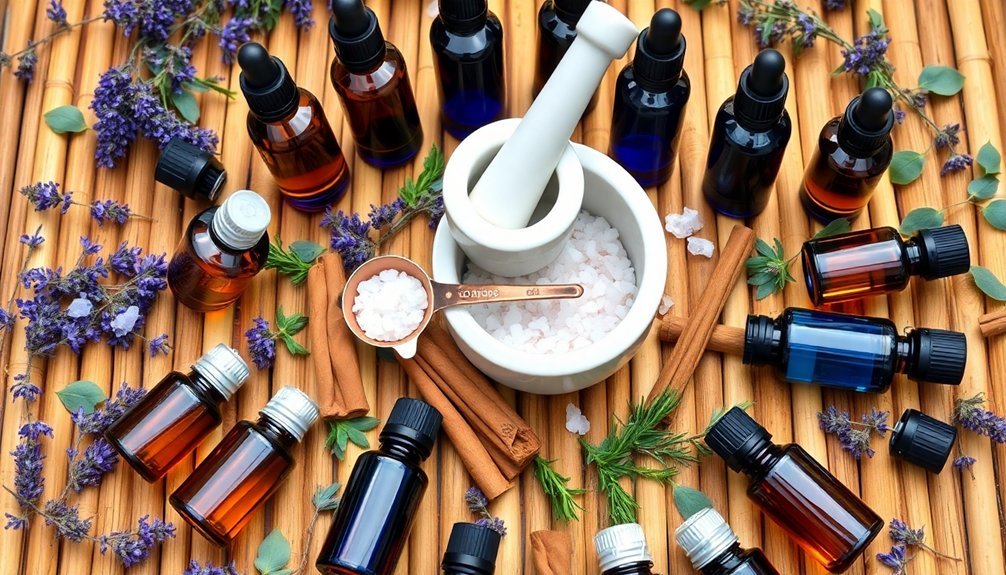
Beyond understanding dilution ratios, mastering the art of blending therapeutic oils creates powerful synergies in your handcrafted soaps. You'll want to blend essential oils using top, middle, and base notes at a 3-5% usage rate for ideal fragrance and therapeutic benefits. Let your essential oil blends rest for 48 hours before starting your soapmaking process.
| Note Level | Examples | Skin Benefits |
|---|---|---|
| Top | Lemon, Mint | Energizing |
| Middle | Lavender, Tea Tree | Calming, Antiseptic |
| Base | Cedarwood, Patchouli | Grounding |
Choose up to three complementary oils to create well-rounded blends that maximize specific skin benefits. This approach guarantees your therapeutic combinations deliver both aromatic harmony and targeted skincare properties, making your handcrafted soaps more effective and enjoyable to use.
Temperature Control and Oil Preservation Methods
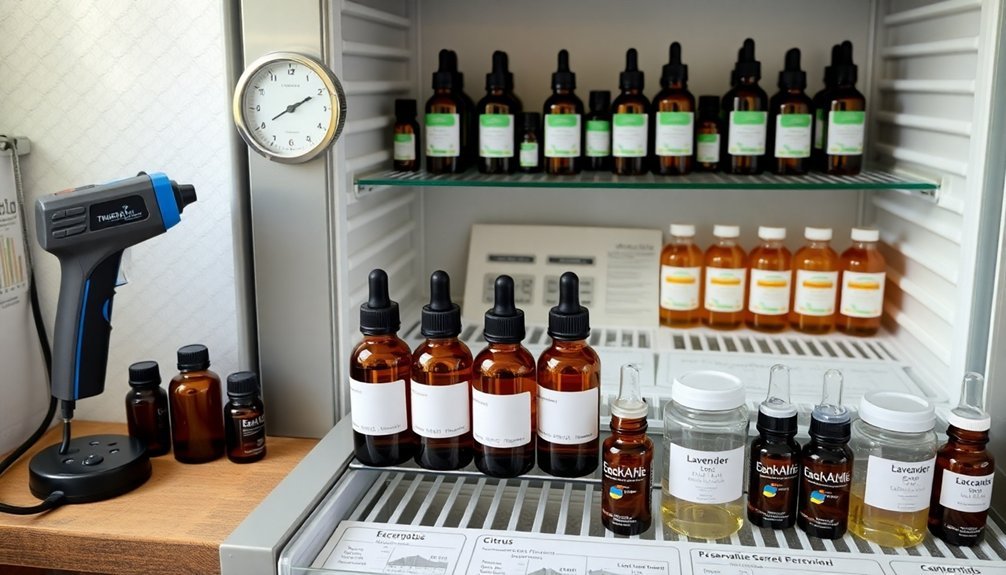
Since therapeutic essential oils are highly sensitive to heat, maintaining strict temperature control throughout your soapmaking process will protect their beneficial properties.
When making cold process soap, you'll want to add your essential oil blend at trace to minimize heat exposure and maximize scent retention.
Here's what you need to know about temperature control and preservation:
- Use a reliable thermometer to monitor temperatures, keeping them below 200°F to prevent essential oils from evaporating during the gel phase.
- Store your essential oils in amber or cobalt blue glass bottles in a cool, dark place.
- Add essential oils at the right moment – after trace in cold process soap, or just before pouring in hot process soap.
- Create well-rounded essential oil blends with middle and base notes to enhance stability and preserve therapeutic benefits.
Base Oil Compatibility and Infusion Processes
Understanding base oil compatibility plays a key role in maximizing the therapeutic benefits of your homemade soaps.
When you're working with essential oils, you'll need carrier oils like olive, coconut, or jojoba to enhance their therapeutic properties while nourishing your skin.
To create potent infusions, you'll want to combine one part of your chosen herbs with five parts base oil.
The infusion process requires patience – it can take several days to weeks for the oil to extract the beneficial compounds fully.
While warmth can speed up the process, don't overheat your mixture.
Once your infusion is complete, you'll need to strain it thoroughly to remove any particles that could affect shelf life.
Storage Requirements for Therapeutic Grade Blends
Proper storage practices make the difference between preserving or wasting your therapeutic grade oil blends.
You'll need dark glass bottles to protect your essential oils from light damage that can degrade their quality. Keep your precious blends in a cool, organized storage space that's away from sunlight and heat sources.
- Label each bottle with the oil name and purchase date to track freshness
- Store therapeutic grade oils in tightly sealed dark glass bottles
- Keep your storage area cool, dry, and away from direct light
- Consider refrigeration for heat-sensitive essential oils
Remember to check each oil's specific storage requirements, as some need extra care to maintain their therapeutic properties.
Measuring Therapeutic Potency in Final Products
Measuring therapeutic potency accurately guarantees your handcrafted soaps deliver the intended benefits without overwhelming or underwhelming effects.
When crafting therapeutic soap, you'll need to ascertain essential oils comprise 3% to 5% of your total soap weight. For a 100g soap bar, you'll use 3g to 5g of oil, which equals about 66 to 110 drops.
Always choose high-quality essential oils to achieve peak therapeutic potency in your final product. You'll want to take into account each oil's unique properties, as some require lower concentrations for safe skin application.
Test your soap's fragrance and effectiveness regularly, making adjustments based on your results and customer feedback. Remember to monitor skin sensitivity reactions to fine-tune your measurements, guaranteeing your therapeutic soap provides consistent benefits.
Frequently Asked Questions
What Is the 30/50/20 Rule for Essential Oils?
You'll create balanced essential oil blends by using 30% top notes for initial burst, 50% middle notes for body, and 20% base notes for longevity. It's a proven formula for well-rounded fragrances.
What Essential Oils Should Not Be Used in Soap?
You shouldn't use bitter almond, undiluted cinnamon bark, or clove oil in soap. Also avoid bergamot, wintergreen, and camphor oils. They're potentially toxic or irritating to your skin when used in soap making.
How Do You Know if Essential Oils Are Therapeutic Grade?
You'll know an essential oil is therapeutic grade if it's labeled "100% pure," has the botanical name and origin listed, comes from reputable brands, and has third-party testing documentation available.
How to Prepare Essential Oils for Soap Making?
You'll need to blend your essential oils 48 hours before soapmaking. Mix them at 3-5% of your base oil weight, add at light trace, and start with lower concentrations (1%) if you're new to soapmaking.
In Summary
You've now mastered the essentials of working with therapeutic grade oils in your soapmaking journey. Remember to always test your oils, maintain proper dilution ratios, and store your blends correctly to preserve their therapeutic properties. Keep monitoring temperatures, choose compatible base oils, and document your results. With these skills, you'll create high-quality soaps that deliver genuine therapeutic benefits to your customers.

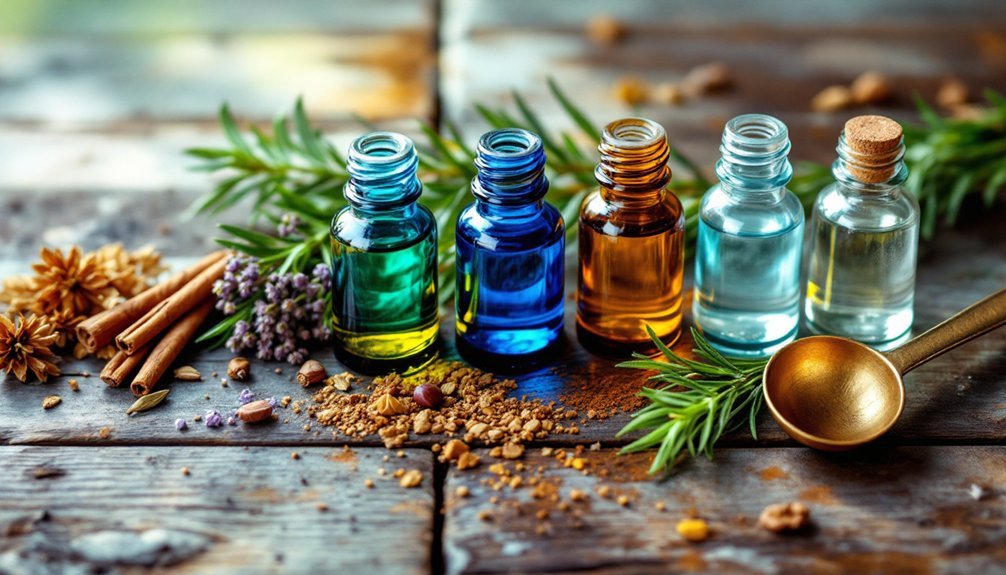



Leave a Reply